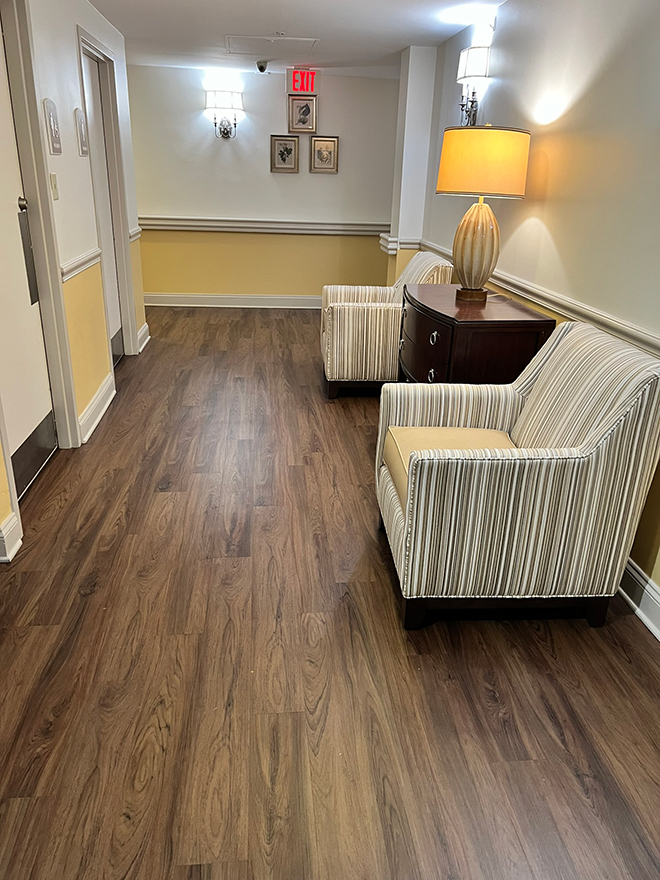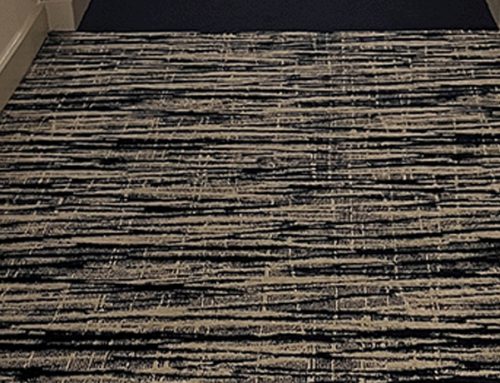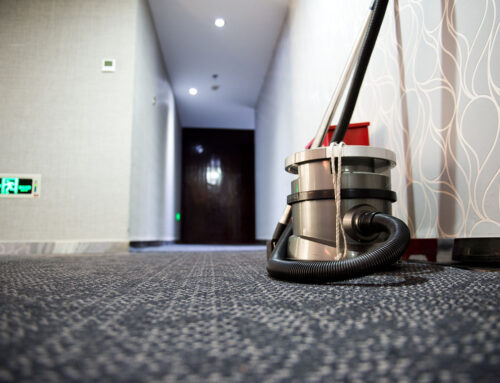Balancing Safety, Comfort, and Style
Designing a senior living community is about more than just creating a beautiful space. It’s about crafting an environment that supports comfort, safety, and dignity for aging adults. Flooring plays a critical role in achieving this balance. From slip resistance to acoustic comfort, the right flooring choices in senior living facilities can enhance residents’ quality of life while reducing maintenance costs and long-term liability.
In this article, we will explore what makes flooring for senior living communities unique, review the most suitable materials for each space, and industry design trends.
Why Flooring Matters in Senior Living Design
Flooring is one of the most heavily used and visually dominant features in any senior care facility. Every step, every wheelchair movement, and every cleaning cycle puts it to the test. But beyond durability, the right flooring must address three critical concerns: safety, comfort, and hygiene.
 1. Safety and Slip Resistance
1. Safety and Slip Resistance
Falls are among the most common and costly incidents in senior housing environments. The Centers for Disease Control and Prevention (CDC) reports that one in four adults over 65 experiences a fall each year. Flooring can help mitigate this risk. Materials with appropriate slip resistance, especially when wet, are essential in high-traffic areas, dining rooms, and bathrooms. Non-glare finishes also reduce visual confusion that can lead to missteps.
2. Ease of Mobility
Senior living communities often see frequent use of mobility aids such as canes, walkers, and wheelchairs. Carpets should provide smooth movement without resistance. Loop pile or tightly woven nylon carpets work well because they resist crushing and make it easier for wheels to glide across the surface.
3. Comfort and Acoustics
A soft, cushion underfoot contributes to comfort and reduces fatigue for residents who spend a lot of time on their feet. Carpet padding can also significantly reduce impact noise between rooms and floors, creating a quieter, more restful atmosphere that promotes relaxation and better sleep.
4. Cleanability and Durability
Senior living carpets must withstand high traffic, spills, and frequent cleaning. Look for stain-resistant fibers and moisture-barrier backings that prevent liquids from seeping into the subfloor. Solution-dyed nylon or polyester carpets are popular choices for their durability and ease of maintenance. Regular vacuuming and professional cleaning schedules will extend the carpet’s lifespan and maintain hygiene standards.
5. Color and Design
Color plays a subtle but important role. Neutral tones with gentle patterns help hide stains and wear, while avoiding high-contrast designs that can cause visual confusion for residents with dementia or vision impairments. Warm, inviting colors can also create a more homelike and comforting environment.
Best Flooring Options for Senior Living Spaces
Different areas within a senior living community have unique needs. Let’s break down the most common flooring materials used today, and where they perform best.
Luxury Vinyl Tile (LVT)
LVT has become the go-to choice for many senior living projects due to its combination of durability, design flexibility, and easy maintenance. Modern LVT products mimic wood, stone, or ceramic tile, offering the warmth of residential aesthetics without the upkeep challenges. Slip-resistant textures and cushioned backing further enhance safety and comfort.
Best for: Resident rooms, corridors, dining areas, and activity spaces.
Sheet Vinyl
For spaces where infection control is a top priority, such as healthcare suites or rehab areas, sheet vinyl provides a seamless, waterproof surface. When heat-welded, it eliminates dirt-collecting seams and is highly resistant to spills and stains. Advances in digital printing also mean sheet vinyl can now replicate high-end finishes once reserved for wood or tile.
Best for: Assisted living wings, skilled nursing units, and medical areas.
Rubber Flooring
Rubber flooring offers exceptional slip resistance, acoustic control, and underfoot comfort—key features for areas where staff and residents spend long hours standing or walking. Its natural resilience also reduces fatigue and joint strain. While it may have a higher upfront cost, its longevity and low maintenance can make it cost-effective over time.
Best for: Therapy rooms, fitness areas, and corridors.
Carpet and Carpet Tile
While carpet is less common in clinical areas, it still plays a vital role in creating a home-like, cozy atmosphere in independent or assisted living spaces. Carpet tiles with low pile height and moisture-resistant backings are ideal—they allow for easy replacement and improved hygiene. Choose subtle, non-busy patterns to prevent visual disorientation in residents with cognitive impairments.
Best for: Lounges, corridors, lobbies, resident suites, and quiet rooms.
Design Trends: Blending Hospitality and Healthcare
The modern senior living community looks and feels more like a boutique hotel than a hospital. Flooring design has evolved accordingly. Natural textures, biophilic patterns, and warm tones help foster a sense of comfort and connection to nature. Multi-tone LVT planks or carpet tiles can create visual interest while subtly defining zones within open-plan layouts.
Another emerging trend is acoustic design. Hard surfaces can amplify noise, which can be stressful or confusing for residents with hearing difficulties. Rubber flooring and acoustic-backed LVT are frequently used to reduce sound transmission and enhance privacy.
Sustainability is also taking center stage. Many manufacturers now offer flooring made from recycled or bio-based materials, with low-VOC adhesives and finishes that contribute to healthier indoor air quality, an especially important consideration for older adults.
Key Takeaways for Designers and Facility Managers
When specifying flooring for a senior living community, consider these guiding principles:
- Prioritize safety: Look for slip-resistant textures and non-glare finishes.
- Balance comfort with mobility: Choose resilient surfaces that support wheelchairs and walkers.
- Think long-term: Evaluate lifecycle costs, not just installation price.
- Design for dignity: Use warm, residential aesthetics to promote a sense of home.
- Simplify maintenance: Select materials that are easy to clean and resistant to spills and stains.
- Support acoustic and environmental wellness: Incorporate flooring that minimizes noise and promotes healthy air quality.
The Bottom Line
Flooring in senior living communities is more than a design decision; it is a cornerstone of resident well-being. By thoughtfully selecting materials that combine safety, aesthetics, and performance, designers and facility managers can create environments that truly enhance quality of life for aging adults while ensuring durability and operational efficiency for years to come.
Whether renovating an existing facility or designing a new one, the right flooring foundation helps set the stage for comfort, independence, and care that feels like home.
Contact Eagle Mat to Learn More about Senior Living Flooring Options.
Eagle Mat provides premium flooring solutions designed for safety, durability, and functionality. Our dedication to providing quality products and exceptional service builds lasting trust with our clients. For more information visit our portfolio or contact us.





